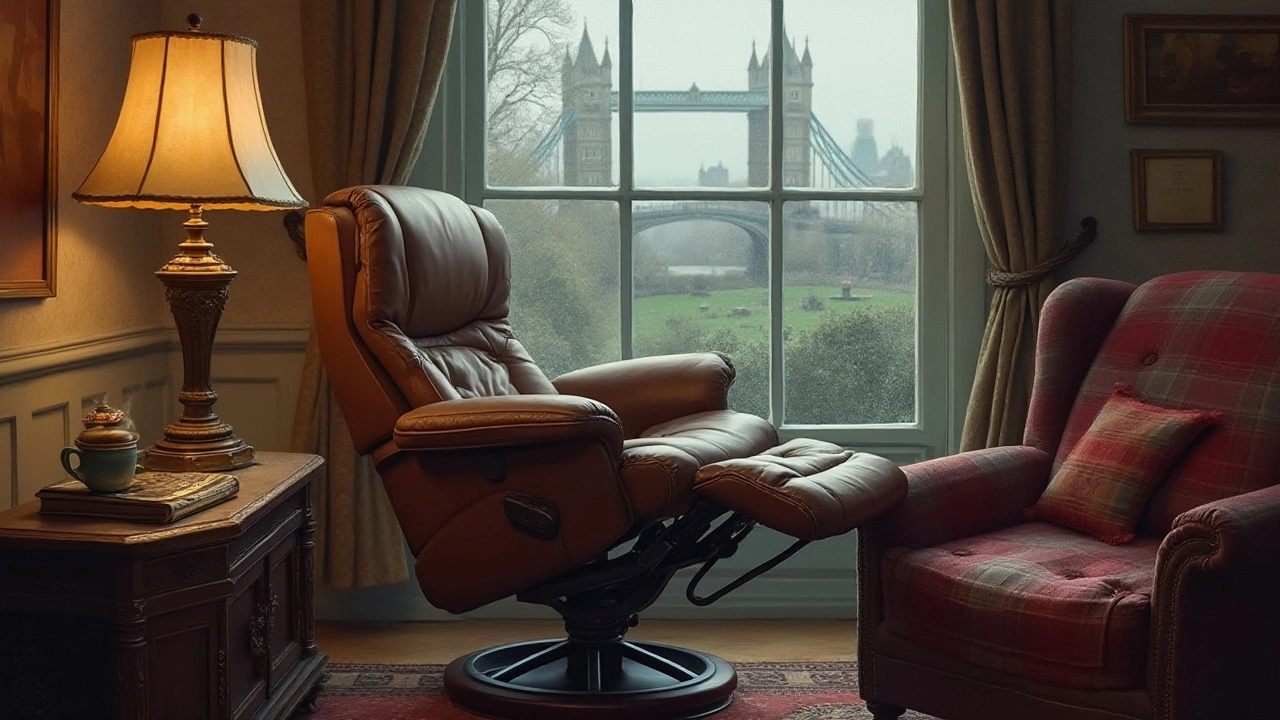Electric recliners have become a staple of modern comfort, offering users the luxury of reclining at the touch of a button. Despite their high-tech allure, these chairs are not immune to problems. When they stop working, it can be frustrating and leave you longing for the relaxation they provide. Understanding why these electric marvels sometimes fail can not only aid in quicker fixes but also help in preventing future hiccups.
Whether it’s something as simple as a power issue or as complex as a motor failure, there are steps you can take to diagnose the problem. By familiarizing yourself with basic troubleshooting techniques, you can ensure your treasured recliner is swiftly restored to its full glory, often without the need for professional help. Dive in as we explore these causes and how you can tackle them head-on.
- Common Causes of Malfunction
- Troubleshooting Power Issues
- Dealing with Remote Control Problems
- Checking and Repairing Wiring
- Motor and Mechanism Failures
- Tips for Maintenance and Longevity
Common Causes of Malfunction
The charm of an electric recliner lies in its smooth functionality and ease of use. Yet, like any other piece of electrical furniture, it may sometimes fail to deliver this comfort, leaving you perplexed as to what might have gone wrong. The first step to resolving this issue is understanding the common causes behind these malfunctions. One of the most frequent culprits is power supply disruption. Whether it's a frayed power cord or a circuit breaker trip, any interruption in electricity can render your recliner immobile. A thorough check for visible damages or connections in the power supply often reveals simple fixes.
Loose connections are another usual suspect in the list of malfunctions. As electric recliners are often moved or adjusted, tangling and tension can lead to loose wiring inside. These internal misalignments might prevent the chair from operating as intended. It's always a good idea to carefully inspect all visible wires and connections periodically for any signs of wear and tear.
Then there are the issues with the control handset. Constant handling can cause remote controls to malfunction, resulting in a partly or entirely unresponsive chair. Sometimes the solution is as simple as replacing the batteries. However, issues such as signal blockages or faulty circuitry within the remote can also be the root cause, requiring more detailed attention. As one seasoned recliner repair technician once said,
"Many recliner issues often turn out to be something as simple as a battery that needs replacing."
Finally, an overlooked but vital component is the electric motor itself. Motors can wear out over time, particularly if poorly maintained. Heated environments or excessive use can also contribute to motor failures. A good maintenance routine, such as periodic lubrication and dirt removal, can often prolong the life of these motors. Recliner malfunction might also stem from mechanical blockages—items caught in the moving parts may halt the chair's function entirely, so it's always best to keep the chair environment tidy.
To keep track of common malfunctions, it's useful to consider the aspects affected most frequently, potentially saving yourself from more significant, costly repairs.
Troubleshooting Power Issues
Power issues are among the most common culprits when your electric recliners suddenly go silent. It may seem trivial, but before diving deep into complex malfunctions, start with the basics. Is the recliner plugged in? You'd be surprised at how often this slips even the sharpest minds. The plug could be partially dislodged, or perhaps your toddler decided it's time for a redirection. Ensuring it fits firmly in the power outlet is the first line of defense against unnecessary worry.
If your recliner chairs are plugged securely, the next step is to inspect the power source. Test the outlet with a separate device, like a lamp or a phone charger. Sometimes, a simple circuit breaker could be your villain, especially after a storm or an electrical spike. Resetting your home’s circuit breaker might just breathe life back into your chair.
"Simple power disruptions often hold the key to unresponsive electric furniture," says Jonathan Hines, a renowned home appliance repair expert, reminding us not to overlook the small details.
The power cord itself can be an issue. Inspect thoroughly for visible damage, such as fraying or cuts. A damaged power cord can interrupt the electric recliner's operation and even pose a safety hazard, so it's vital to replace it if needed. Use a multimeter if handy, to check for proper voltage passing through the cord. This gadget can confirm if your lower priced recliner malfunction isn't lurking within your power line.
Now, moving to the internal system, one should be aware of the recliner’s power transformer. This is often a black rectangular unit that converts your household current into something suitable for your recliner. When faulty, it will not relay power at the needed voltage. Swapping it out temporarily with a compatible spare, if available, can narrow down the cause. Make sure the recliner’s transformer output matches the required specifications, usually noted near the power input socket. This information will guide you to the right replacement should it be necessary.
In rare instances, the internal fuse may have blown. This happens when fluctuations in power cause the recliner to draw too much electricity. Access your recliner’s internal compartment and locate the fuse box. Replace the fuse with a matching type and rating if found burnt out. If you're not confident delving into the machinery, this might be the point to consult the manufacturer's customer service.
Power supply strips, often used for adding multiple devices to a single outlet, can sometimes complicate matters. These strips can fail, losing their ability to handle multiple outlets due to age or damage. Try plugging the recliner directly into the wall outlet to bypass this potential obstacle. Sometimes, plugins used by multiple devices don't provide each one with adequate power, causing them to underperform or shut down completely.
Dealing with Remote Control Problems
Picture this: You’ve just sunk into your beloved electric recliner, ready to lean back and relax, but nothing happens when you press the button on the remote control. One of the most common issues with electric recliners stems from faulty remote controls, which may be caused by a range of issues from simple dead batteries to more complex electronic problems. It's essential to first check the obvious—ensure the remote has fresh batteries. This is often overlooked, but a simple battery swap can make a world of difference.
Diving deeper, another potential issue might be interference from other electronic devices. Home Wi-Fi routers and other remote-controlled devices might operate on a similar frequency, causing the recliner's remote to act up. Try moving these devices further away, or testing the recliner with different remote settings if possible. Also, observe if any specific actions trigger the remote’s failures, as this can pinpoint precise interference sources.
"The most significant contributor to remote control malfunctions is usually environmental interference, which people tend to overlook," notes a study from the National Home Furnishings Association.
Lastly, consider the internal wiring of the remote control itself, which might be compromised due to wear and tear. It's worth inspecting the wiring connections inside the remote if you’re comfortable with handling electronics. Look for loose connections or frayed wires. If you do discover damaged wiring, it may require soldering skills or a professional touch, but sometimes simply repositioning loose wires can restore function. A universal remote could also be a handy backup solution if your specific model is prone to frequent issues. Should your repair efforts fail, there are usually compatible universal remotes available through the manufacturer or third-party retailers.
For those who prefer a more structured approach, here’s a step-by-step guide to troubleshooting your recliner's remote:
- Check and replace the batteries in the remote control.
- Ensure that there are no obstacles blocking the signal path between the remote and the recliner.
- Move other electronic devices away to minimize potential interference.
- Open up the remote casing and inspect for any visible damage or loose wires.
- If necessary, test the remote on a similar model to check its compatibility or effectiveness.
- If stuck, consider using a universal remote control as a temporary or permanent fix.
Maintenance of electric recliners extends beyond just mechanical parts: even seemingly minor issues like remote control malfunctions require patience and attention to detail. By delving into the specifics of how these devices work and knowing your options, you can mitigate many of these inconvenient interruptions. The key lies in understanding your recliner’s requirements and using this knowledge as a preventative measure, keeping your relaxation uninterrupted for years to come.

Checking and Repairing Wiring
When it comes to keeping your electric recliners in top condition, one of the most critical components is the wiring. Over time, the wires in your recliner can become damaged or dislodged, leading to various issues, such as sputtering controls or completely cutting off power to your chair. You'll want to start by ensuring the chair is completely turned off before you do any work. Safety is paramount, and you wouldn't want any unintentional electricity coursing through while you inspect.
Once you've ensured safety, take a careful look at where the electric recliner connects to the power source. Sometimes, the problem can be as basic as a loose plug or a damaged cord. Feel free to gently wiggle any visible wires; if they're loose, you've likely found the source of your problem. While these troubleshooting steps might sound simple, they're critical processes in pinpointing why your recliner may not be functioning optimally.
A more intricate task involves examining the internal wiring. You may need to flip the recliner and take a closer look at its undersides, where much of the wiring is housed. Here you'll find a web of connections that could intimidate even the most enthusiastic DIYer. Typically, there's a power panel and various colored wires. Watch for anything that's frayed or disconnected. Wire connectors should be firm; if you find one moving freely, secure it tightly to prevent any future complications.
Using a multimeter to test for electrical continuity can be a valuable tool in this process. A lack of current flow may point to internal disruptions, meaning you may face a more serious issue. Not everyone is comfortable working with electrical components, though, and if that describes you, it might be best to consult a professional before proceeding. As noted by Steve Ford in Home Tech Magazine, "While DIY fixes can be efficient, sometimes the precision of a professional is irreplaceable."
For those who feel up to the task, replacing or repairing damaged wiring calls for some basic electrical supplies: wire strippers, electrical tape, and possibly some replacement wire of the same gauge and material. Ensure all new connections are secure and insulated properly to prevent issues down the line. Remember, it's worth investing time into making these repairs robust to enjoy your recliner's comforts for years to come.
Don't forget the simple act of maintenance. Regular checks can prevent many issues before they arise. By periodically inspecting the wiring and doing a bit of cleaning, you can significantly extend the life of your electric recliner. Doing this not only helps you savor more time in the cozy embrace of your chair but also minimizes the likelihood of more troublesome repair needs in the future.
Motor and Mechanism Failures
When it comes to electric recliners, one of the most complex components can be the motor and its associated mechanisms. These parts work tirelessly to deliver the smooth reclining action that many have come to cherish. However, with this intricate functionality comes the potential for issues. A motor that's making strange noises or refusing to move might be struggling for various reasons. One common culprit is debris or dirt accumulation, which can block the smooth operation of the gears or moving parts. With regular cleaning, you can keep these issues at bay before they escalate into more serious problems.
Another point to consider is the age of the motor. Like all machinery, they aren't designed to last forever. Over time, wear and tear can lead to decreased functionality. If you notice that the recliner is moving slower than it used to, it might be an early sign of motor fatigue. While it's possible to replace the motor, it's essential to ensure compatibility with your specific model. If you're unsure, contacting the manufacturer can often clarify which parts are suitable for replacement. A correctly fitted motor will ensure longevity and continued comfort.
“The complexity of modern furniture mechanisms often means that DIY enthusiasts can inadvertently cause more harm than good,” advises Jenna Mahoney, a respected expert in home furnishings. “It’s always a good idea to consult the manufacturer for guidance when considering repairs.”
Interestingly, a less obvious factor that can lead to motor and mechanism failures is fluctuating power. Without a stable power supply, motors may not receive the consistent energy they need to function properly. This can eventually lead to premature burnout. It's advisable to use a surge protector with your electric recliner. Not only does this protect the motor and mechanism from unexpected power spikes, but it also ensures a steady flow of electricity, preserving the motor's lifespan.
For those who like empirical evidence, studies on motor resilience in recliners have shown that approximately 15% of issues are due to manufacturing defects. While this is relatively low, it suggests the importance of buying from reputable brands known for quality. A table below illustrates the most common motor issues encountered in electric recliners, alongside their average frequency.
| Issue | Frequency (%) |
|---|---|
| Noise During Operation | 30% |
| Slow Movement | 25% |
| Complete Failure | 20% |
| Intermittent Functionality | 15% |
Tackling motor and mechanism failures isn't just about spot-fixes. Regular maintenance is crucial. Lubricating the moving parts can ensure they operate without strain. Adjusting the recliner at regular intervals can also help distribute the stress equally across the motor's mechanics, mitigating the risk of failure. Awareness and proactive care can extend the life of your recliner, keeping it a cherished part of relaxation and comfort in your home for years to come.
Tips for Maintenance and Longevity
Maintaining your electric recliners to ensure they serve you well over the years doesn't have to be a daunting task. Regular checks and simple upkeep can vastly extend the life of your favorite chair. At the heart of these recliners lies an intricate system of motors, wiring, and gears, all working in harmony. If neglected, even the most minor issues can escalate into significant problems. But with a little TLC, your chair can remain as good as new for years. Start with a regular cleaning routine. Dust and debris often find a home in the crevices of your recliner, potentially causing wear or even jamming moving parts. A weekly wipe-down with a gentle cleanser can prevent this. Make sure to unplug the chair and focus on the nooks and crannies where dirt loves to hide.
Another crucial tip is to inspect the wiring. Much like any other electronic device, loose or frayed wires can not only stop your recliner from functioning but also pose a significant safety risk. Every few months, flip your chair over and have a look. If you spot any concerning wires, it might be time to call an expert. Of course, lubrication is to your recliner what oil is to a car engine. Keeping the moving parts well-lubricated can prolong their life and ensure smooth operation. Using a silicone-based lubricant a few times a year can make all the difference. While you're at it, double-check the screws and bolts. They can sometimes loosen over time due to regular use, which can lead to instability or noise. Tightening them as needed is a simple way to maintain the stability of your recliner.
Protecting Materials
The fabric or leather upholstery of your recliner is just as important. Prevention is often better than cure, and this holds true for upholstery care. Consider placing your recliner away from direct sunlight to prevent fading or cracking, especially if it boasts a leather finish. A regular vacuum can lift dirt and prevent it from settling in. If your recliner has leather upholstery, invest in a quality leather conditioner to keep it supple and less prone to cracking. For fabric, using a fabric protector can fend off unwanted stains and spills.
Balancing Usage and Rest
It's essential to also consider how often you're using your recliner. Give it a periodic break if it's a heavily-used piece of furniture. Much like you might need a rest after a busy day, your recliner benefits from a little downtime too. This isn't just good for the upholstery but also for the internal mechanics. Every once in a while, switch it off, unplug it and leave it idle for a few hours. This can often help to reset any minor electronic glitches it's facing - much like giving your computer a reboot.
"Recliners are blessed with a longer lifetime with simple maintenance practices," suggests Dr. Emily Harris, an expert in furniture design and maintenance. "A little consistent care can result in years of relaxed comfort."
Don't overlook the motor health. Listen for any unusual sounds during operation. Grinding or clicking noises can indicate the need for closer inspection. Catching such signs early can save on costly repairs or even replacement. By following these maintenance tips, not only do you extend the life of your beloved recliner chairs, but you also ensure an ongoing and smooth reclining experience. The efforts you put into care today directly infuses additional years of comfort tomorrow.








